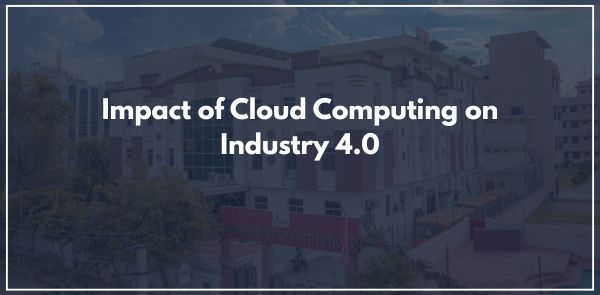
The Fourth Industrial Revolution, or Industry 4.0, represents a paradigm shift in the way industries operate. It integrates advanced technologies like the Internet of Things (IoT), Artificial Intelligence (AI), Robotics, big data, and Cloud computing to create smart factories and highly automated industrial processes. Among these technologies, cloud computing plays a pivotal role, serving as the backbone for data storage, processing, and seamless connectivity across all facets of modern industry.
Recognizing the need for future ready professionals, the Poddar Group of Institutions- a top college for IT education in Jaipur- offers advanced programs that incorporate these cutting-edge technologies in there BCA and MCA curriculums, ensuring students are equipped for Industry 4.0.
Industry 4.0 marks a new era of industrial transformation that emphasizes automation, real-time data exchange, and interconnected systems. Unlike earlier industrial revolutions that were driven by steam power, electricity, or digital computing, Industry 4.0 is characterized by cyber-physical systems, IoT-enabled devices, and smart analytics that operate collaboratively to enhance productivity and efficiency.
Cloud computing refers to the delivery of computing services—servers, storage, databases, networking, software, analytics, and more—over the internet, or “the cloud.” It provides organizations with flexible resources, faster innovation capabilities, and economies of scale. The core service models—Infrastructure as a Service (IaaS) Platform as a Service (PaaS), and Software as a Service (SaaS) — support a wide range of industrial applications and enable scalable solutions without significant upfront investments.
One of the most significant contributions of cloud computing to Industry 4.0 is scalability. Industries can scale their computing resources up or down according to demand without investing in physical infrastructure. This flexibility is crucial for manufacturing environments that face fluctuating market demands and need to adjust production levels dynamically.
Cloud platforms enable rapid deployment of new applications, facilitate testing environments, and support remote updates—features that help industries adapt to changes quickly and cost-effectively.
Industry 4.0 relies heavily on real-time data for predictive maintenance, supply chain optimization, and quality control. Cloud computing provides the infrastructure necessary for collecting, storing, and analyzing vast amounts of data generated by machines and sensors. With cloud-based analytics tools, manufacturers can gain insights into performance metrics, detect anomalies early, and make data-driven decisions.
Predictive analytics powered by AI and machine learning, (are integrated into BCA and MCA cloud computing courses to prepare students for data –driven industries), both typically hosted on cloud platforms, —allow companies to foresee equipment failures and minimize downtime, thereby saving costs and improving overall efficiency.
The Internet of Things is a core component of Industry 4.0, enabling machines, devices, and systems to communicate with one another. Cloud computing provides the platform through which IoT devices send, receive, and process data. Without the cloud, managing the vast volume of data generated by thousands of sensors would be impractical.
Cloud-based IoT platforms centralize data management, ensure secure communications, and offer tools for remote device monitoring. This setup enables the creation of smart factories where production systems autonomously adjust operations in real time to meet goals like energy efficiency or error reduction.
Adopting cloud computing reduces the need for physical servers and data centers, minimizing capital expenditures and operational costs. Companies only pay for what they use, and cloud service providers manage the maintenance, security, and upgrades.
Moreover, cloud solutions facilitate centralized resource management and allow teams across multiple locations to collaborate efficiently. This is especially beneficial for global companies aiming to standardize operations and maintain uniform quality across international manufacturing sites.
In an increasingly globalized world, industrial teams are often distributed across different locations. Cloud computing enables remote collaboration by providing access to shared data, applications, and systems from any device with internet connectivity. Engineers can remotely monitor machines, troubleshoot issues, or even reprogram equipment from anywhere in the world.
This level of connectivity became especially crucial during the COVID-19 pandemic, where remote work capabilities proved essential for business continuity.
Security is a major concern in Industry 4.0 due to the interconnected nature of devices and systems. Cloud providers invest heavily in cybersecurity, offering features such as encryption, multi-factor authentication, intrusion detection systems, and compliance with industry standards like ISO 27001 or GDPR.
By leveraging these security measures, companies can protect sensitive data and ensure compliance with regulations, which is increasingly important in industries such as healthcare, automotive, and aerospace.
Despite its benefits, integrating cloud computing into Industry 4.0 comes with challenges. Concerns about data privacy, latency, and dependency on service providers persist. Additionally, industries must manage the complexity of migrating legacy systems to the cloud and ensuring interoperability between various platforms and devices.
Edge computing is emerging as a complementary technology to address latency and bandwidth issues by processing data closer to the source, but the integration between edge and cloud solutions must be managed carefully.